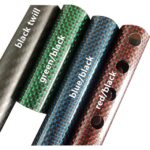소개
현대 제조업의 영역에서 혁신적인 소재가 등장했습니다. CNC 탄소 섬유. 이 글은 기존 소재와 비교하여 그 중요성을 조명하는 것을 목표로 합니다. 두 소재의 차이점, 적용 분야, 성능, 비용 및 환경 영향 측면에서 서로 어떻게 비교되는지 살펴보겠습니다.
CNC 탄소 섬유의 이해
CNC 탄소 섬유란 무엇인가요?
CNC 탄소 섬유는 강도, 경량, 다용도성이 특징인 최첨단 소재입니다. 탄소 섬유 시트와 정밀 CNC(컴퓨터 수치 제어) 가공의 융합으로 탄생한 이 소재는 탁월한 정밀도와 디자인 유연성을 제공합니다.
생산 프로세스
CNC 탄소 섬유 생산에는 탄소 섬유 시트를 겹겹이 쌓고 수지로 결합하는 과정이 포함됩니다. 그런 다음 이러한 층을 CNC 기계를 사용하여 모양을 만들고 절단하여 높은 정확도와 일관성을 보장합니다.
애플리케이션 및 이점
CNC 탄소 섬유는 우수한 중량 대비 강도 비율과 적응성 덕분에 항공우주, 자동차, 스포츠 장비 등 다양한 분야에서 사용되고 있습니다.
전통 소재 개요
일반적인 전통 재료
강철, 알루미늄, 플라스틱과 같은 전통적인 소재는 오랫동안 제조업의 근간이 되어 왔습니다. 각 재료는 고유한 특성과 용도를 가지고 있습니다.
성능 비교
강도 및 무게
CNC 탄소 섬유와 기존 소재의 가장 두드러진 차이점 중 하나는 무게 대비 강도 비율입니다. CNC 탄소 섬유는 이 측면에서 대부분의 소재보다 성능이 뛰어나며, 훨씬 적은 무게로 높은 강도를 제공합니다.
내구성 및 유지 관리
내구성 측면에서 CNC 탄소 섬유는 부식과 마모에 강해 일부 기존 소재에 비해 유지보수 필요성이 낮다는 장점이 있습니다.
정밀도 및 가공성
탄소 섬유의 CNC 가공이 제공하는 정밀도는 타의 추종을 불허하며, 기존 소재에서는 종종 어려운 복잡한 디자인과 엄격한 공차를 제공합니다.
비교 애플리케이션
주요 산업 분야에서의 애플리케이션
항공우주 및 자동차 산업에서 CNC 탄소 섬유는 연비 및 성능 향상으로 이어지는 경량화 이점으로 인해 점점 더 인기를 얻고 있습니다. 반면 기존 소재는 비용이나 특정 소재 특성이 우선시되는 애플리케이션에서 계속 사용되고 있습니다.
비용-편익 분석
초기 투자 및 장기 비용
CNC 탄소 섬유의 초기 투자 비용은 높을 수 있지만, 내구성이 뛰어나고 유지 관리 비용이 적게 들어 장기적으로 유리한 비용 프로파일을 제공합니다.
ROI 및 TCO
투자수익률(ROI)과 총소유비용(TCO)을 분석한 결과, 초기 비용에도 불구하고 CNC 탄소 섬유는 특히 고유한 특성이 필수적인 애플리케이션에서 장기적으로 더 경제적일 수 있다는 사실이 밝혀졌습니다.
환경 영향 및 지속 가능성
제조 공정 영향
CNC 탄소섬유 생산에 따른 환경 영향은 상당하지만, 제조 기술의 발전과 재활용 노력을 통해 완화할 수 있습니다.
재활용 가능성 및 수명 주기 평가
CNC 탄소 섬유와 기존 소재는 모두 재활용성과 환경 영향의 정도가 다르며, 이는 수명 주기 평가에서 중요한 고려 사항입니다.
향후 동향 및 개발
CNC 탄소 섬유의 혁신
CNC 탄소 섬유의 지속적인 기술 발전은 앞으로 더욱 폭넓은 응용 분야와 효율성 향상을 약속합니다.
전통 소재의 진화
마찬가지로 전통적인 소재도 고정된 것이 아니라 지속적인 연구와 개발을 통해 그 특성과 활용도가 계속 향상되고 있습니다.
결론
요약하자면, CNC 탄소 섬유와 기존 소재는 각각 고유한 강점과 응용 분야가 있습니다. 제조 및 설계에서 정보에 입각한 결정을 내리기 위해서는 두 소재의 차이점과 각각의 장점을 이해하는 것이 중요합니다.


